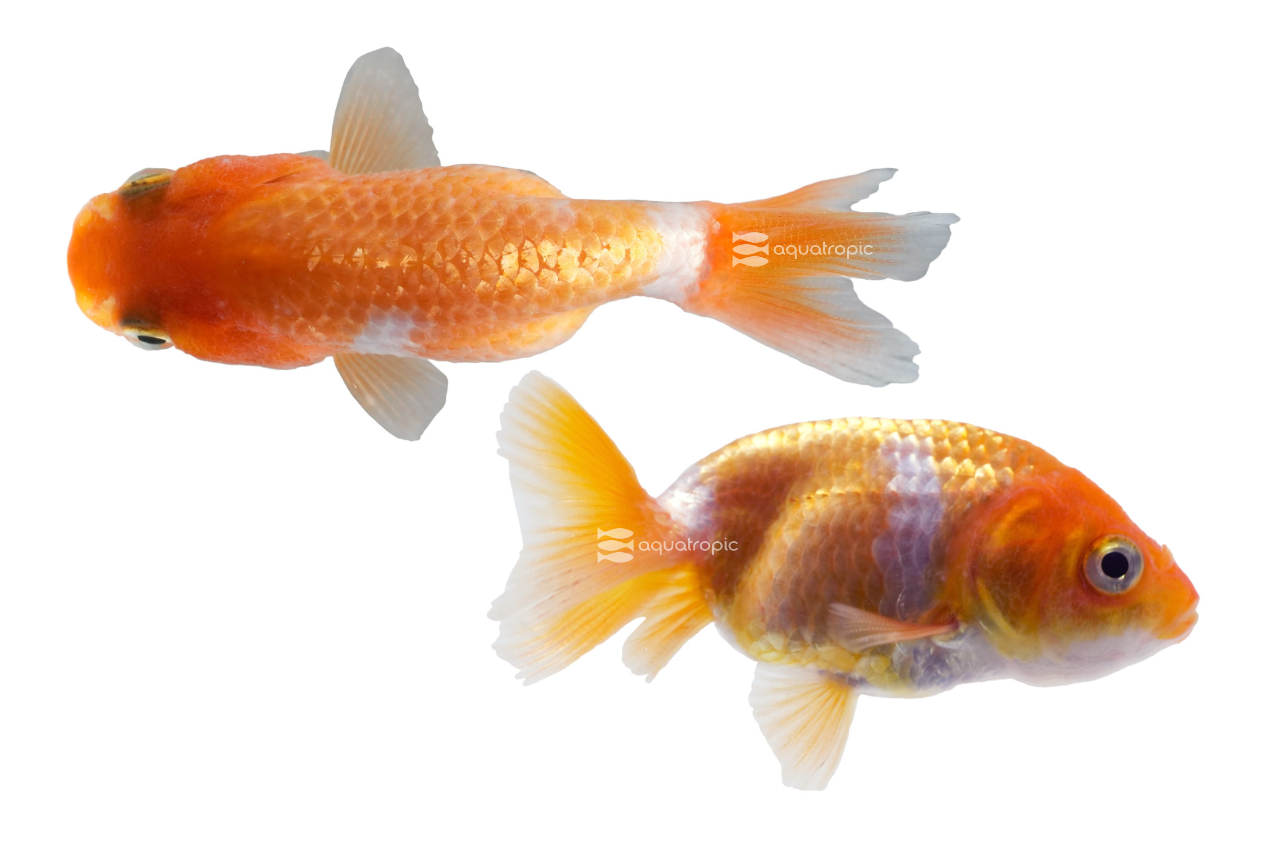Say it with us...RANCHU

The Ranchu Goldfish is a favorite here among our Aquatropic staff as well as with goldfish enthusiasts around the globe. It is sometimes called the "king of goldfish" due to its regal appearance, but most goldfish don't know they have a king, being more of an autonomous collective. Ranchu Goldfish are defined from other fancy Goldies by their pronounced, rounded bodies and lack of dorsal fins. Where this dorsal fin should be, there is a rounded, smooth hump (aka hood) instead.
As you've likely guessed, Ranchu goldfish are not found in the wild, fancy Goldfish being a product of literally hundreds of years of selective breeding. In the beginning, their ancestors likely came from Central Asia, and if you're interested in where the myriads of cultured goldfish originated, we have a “history of goldfish” article elsewhere on the website.

Ranchu Goldies are like most fancy goldfish in that they need two things to thrive. One is a good diet (which we'll touch on here soon), and the other is a clean, cool tank. Neither of these is all that difficult to supply. These fish regularly get five to eight inches long in the home aquarium, and while active, aren't the strongest swimmers. A group of five could easily be kept in a tank as small as 55 gallons, with no limit to the upper size, we've even seen them in ponds, where they are beautiful. These tanks should have some substrate like soft sand or small rounded pebbles as Goldfish like to dig around a bit. They don't need a ton of décor, so plan for an aesthetic rather than a biotope, just make sure everything that goes in there is aquarium safe and doesn't have sharp corners. Goldfish tanks look great with minimalist designs and open space is appreciated by the fish as well. Your Ranchus will love plants in aquariums, consuming the softer plants with vigor, and will really enjoy rooting around in the substrate and digging up anything trying to put down roots there. If you are set on having a planted Goldfish aquarium, we recommend reading up on durable plants, or just utilizing fake ones.
All goldfish like cooler water than most tropical aquarium fish, and while they can live in temperatures up into the high 70s, they'll live longer and be more active and healthier in aquariums that are maintained in the mid 60's to the low 70s. The pH they are kept in isn't wildly important as long as it is close to neutral (7.0) and stable. They will do best in very clean water, but also can't handle a ton of flow, so filtration needs to be well planned and return flow very diffuse; keep nitrates under 10ppm.

Likely the most important part of keeping any fancy goldfish happy for life is their diet. Firstly, food needs to sink, because you don't want the fish ingesting a lot of air. Here we use Nutramar's Algae and Color Boost sinking pellets, which offer a balanced diet and dissociate completely in the fish's gut preventing digestive issues. Many goldfish keepers recommend supplementing a processed diet with vegetable matter. With most fish we don't recommend using terrestrial vegetables, but with goldfish, this practice has been around longer than glass tanks, so it has stood the test of time. Any veggies that get offered to your Goldies should always be blanched before feeding. Blanching is basically dropping the fresh veg in boiling water and then removing it after a few seconds, then dropping it immediately into ice water to stop the cooking. This helps the tougher fibers in the plant matter to break down while maintaining nutritive value (honestly, it’s a great way to cook spinach for yourself too if you haven't tried it.) Some good veggie choices includes; lettuce, kale, spinach, and peas, though some people swear by broccoli and even apples or pears. If you notice that your Ranchu hasn't been de rug snuiten (as the Dutch say), up the blanched veggie routine. Most of you won't ever have this issue if you're feeding a quality pellet.
Breeding goldfish isn't as easy as say, guppies, but it is usually not all that complicated. Start with a four of five fish and get them into condition with lots of high-quality food and excellent water quality. Give them plenty of places to lay eggs like silk plants or spawning mops. Day by day lower the temperature of the tank till it's around 60 degrees Fahrenheit (you might have to do this in a cool place in your home, like a basement.) Once you hit your lowest temp, reverse the process and warm the tank back up until you get back to the low 70s, at this point, the fish should spawn. If it doesn't work, give them a month or so and try again. You'll notice the males chasing the females around and they'll do a little dance together near a spawning surface. Once you notice eggs, you can remove whatever they spawned on and put it in its own tank (Goldfish are bogus parents and are probs gonna eat the kids.) Eggs should hatch in about a week and can be fed fairly large foods right away, like powdered pellets and Gamma Nauplii or Copepods.
Ranchu Goldfish are gorgeous, hardy, active, and the lack of dorsal fin makes them super unique. They can be trained to eat from your hands and definitely respond to people. With good care (and a spot of luck), Ranchu goldfish can live for more than a decade! If you're interested in the King of Goldfish, head into your LFS and have them order you a group of Ranchu Goldfish from Aquatropic today!